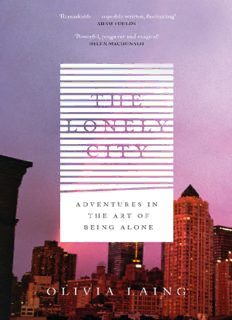
The Lonely City: Adventures in the Art of Being Alone PDF
Preview The Lonely City: Adventures in the Art of Being Alone
Also by Olivia Laing To the River The Trip to Echo Spring OLIVIA LAING The Lonely City Adventures in the Art of Being Alone Published in Great Britain in 2016 by Canongate Books Ltd, 14 High Street, Edinburgh EH1 1TE www.canongate.tv This digital edition first published in 2016 by Canongate Books Copyright © Olivia Laing, 2016 The moral right of the author has been asserted For permissions acknowledgements, please see the Notes beginning on page 285 Every effort has been made to trace copyright holders and obtain their permission for the use of copyright material. The publisher apologises for any errors or omissions and would be grateful if notified of any corrections that should be incorporated in future reprints or editions of this book. British Library Cataloguing-in-Publication Data A catalogue record for this book is available on request from the British Library ISBN 978 1 78211 123 8 eISBN 978 1 78211 124 5 Typeset in Bembo by Palimpsest Book Production Ltd, Falkirk, Stirlingshire If you’re lonely, this one’s for you and every one members one of another Romans 12:5 CONTENTS 1 The Lonely City 2 Walls of Glass 3 My Heart Opens to Your Voice 4 In Loving Him 5 The Realms of the Unreal 6 At the Beginning of the End of the World 7 Render Ghosts 8 Strange Fruit Notes Bibliography Acknowledgements List of Illustrations 1 THE LONELY CITY IMAGINE STANDING BY A WINDOW at night, on the sixth or seventeenth or forty- third floor of a building. The city reveals itself as a set of cells, a hundred thousand windows, some darkened and some flooded with green or white or golden light. Inside, strangers swim to and fro, attending to the business of their private hours. You can see them, but you can‘t reach them, and so this commonplace urban phenomenon, available in any city of the world on any night, conveys to even the most social a tremor of loneliness, its uneasy combination of separation and exposure. You can be lonely anywhere, but there is a particular flavour to the loneliness that comes from living in a city, surrounded by millions of people. One might think this state was antithetical to urban living, to the massed presence of other human beings, and yet mere physical proximity is not enough to dispel a sense of internal isolation. It’s possible – easy, even – to feel desolate and unfrequented in oneself while living cheek by jowl with others. Cities can be lonely places, and in admitting this we see that loneliness doesn’t necessarily require physical solitude, but rather an absence or paucity of connection, closeness, kinship: an inability, for one reason or another, to find as much intimacy as is desired. Unhappy, as the dictionary has it, as a result of being without the companionship of others. Hardly any wonder, then, that it can reach its apotheosis in a crowd. Loneliness is difficult to confess; difficult too to categorise. Like depression, a state with which it often intersects, it can run deep in the fabric of a person, as much a part of one’s being as laughing easily or having red hair. Then again, it can be transient, lapping in and out in reaction to external circumstance, like the loneliness that follows on the heels of a bereavement, break-up or change in social circles. Like depression, like melancholy or restlessness, it is subject too to pathologisation, to being considered a disease. It has been said emphatically that loneliness serves no purpose, that it is, as Robert Weiss puts it in his seminal work on the subject, ‘a chronic disease without redeeming features’. Statements
Description: